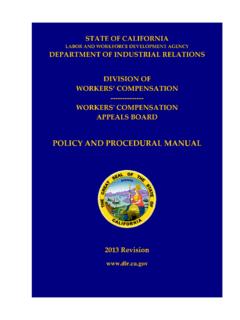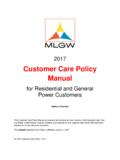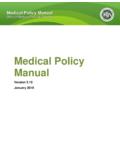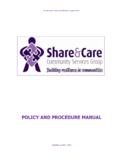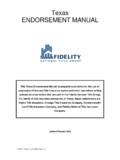Transcription of CODEX ALIMENTARIUS COMMISSION
1 procedural MANUALCODEX ALIMENTARIUS COMMISSIONISSN 1020-8070C O D E X A L I M E N T A R I U SJoint FAO/WHO Food Standards ProgrammeNineteenth editionFor further information on the activities of the CODEX ALIMENTARIUS COMMISSION ,please contact:Secretariat of the CODEX ALIMENTARIUS CommissionJoint FAO/WHO Food Standards ProgrammeFood and Agriculture Organization of the United NationsViale delle Terme di Caracalla00153 Rome, ItalyTelephone: +39 06 57051 Fax: +39 06 57053152/57054593 Telex: 625852 or 625853E-mail (Internet): site: publications may be obtained through the worldwide Sales Agents of FAO or by writing to:Sales and Marketing GroupFood and Agriculture Organization of the United NationsViale delle Terme di Caracalla00153 Rome, ItalyFax: +39 06 57053360 Email: by the Secretariat of the Joint FAO/WHO Food Standards Programme, FAO, RomeThe designations employed and the presentation of material in this information product do not imply the expression of any opinion whatsoever on the part of the Food and Agriculture Organization of the United Nations (FAO) or of the World Health Organization (WHO) concerning the legal or development status of any country, territory, city or area or of its authorities, or concerning the delimitation of its frontiers or boundaries.
2 The mention of specific companies or products of manufacturers, whether or not these have been patented, does not imply that these have been endorsed or recommended by FAO or WHO in preference to others of a similar nature that are not 978-92-5-106493-1 All rights reserved. Reproduction and dissemination of material in this information product for educational or other non-commercial purposes are authorized without any prior written permission from the copyright holders provided the source is fullyacknowledged. Reproduction of material in this information product for resale or other commercial purposes is prohibited without written permission of the copyright holders. Applications for such permission should be addressed to: Chief Electronic Publishing Policy and Support BranchCommunication Division FAO Viale delle Terme di Caracalla, 00153 Rome, Italy or by e-mail to: FAO and WHO 2010 TABLE OF CONTENTS TABLE OF CONTENTS.
3 Iii SECTION I: BASIC TEXTS AND 3 Statutes of the CODEX ALIMENTARIUS 4 Rules of Procedure of the CODEX ALIMENTARIUS COMMISSION .. 6 General Principles of the CODEX ALIMENTARIUS .. 17 Definitions for the Purposes of the CODEX ALIMENTARIUS .. 18 SECTION II: ELABORATION OF CODEX STANDARDS AND RELATED 21 Procedures for the Elaboration of CODEX Standards and Related Texts .. 22 Criteria for the Establishment of Subsidiary Bodies of the CODEX ALIMENTARIUS COMMISSION .. 31 Criteria for the Establishment of Work Priorities .. 33 Relations Between Commodity Committees and General Subject Committees .. 34 Format for CODEX Commodity Standards .. 39 Guidelines for the Inclusion of Specific Provisions in CODEX Standards and Related 43 Procedures for Consideration of the Entry and Review of Food Additive Provisions In the General Standard for Food Additives.
4 43 Guidelines on the Elaboration and/or Revision of Codes of Hygienic Practice for Specific Principles for the Establishment of CODEX Methods of Principles for the Establishment or Selection of CODEX Sampling Procedures ..62 The Use of Analytical Results: Sampling Plans, Relationship Between the Analytical Results, the Measurement Uncertainty, Recovery Factors and Provisions In CODEX SECTION III: GUIDELINES FOR SUBSIDIARY BODIES .. 67 Guidelines to Host Governments of CODEX Committees and Ad Hoc Intergovernmental Task 68 Guidelines on the Conduct of Meetings of CODEX Committees and Ad Hoc Intergovernmental Task 73 Guidelines to Chairpersons of CODEX Committees and Ad Hoc Intergovernmental Task 76 Guidelines on Physical Working 79 Guidelines on Electronic Working Groups.
5 82 SECTION IV: RISK ANALYSIS .. 85 Working Principles for Risk Analysis for Application In the Framework of the CODEX ALIMENTARIUS .. 86 Definitions of Risk Analysis Terms Related to Food 92 Risk Analysis Principles Applied by the CODEX Committee on Food Additives and the CODEX Committee on Contaminants In Foods .. 94 iii Policy of the CODEX Committee on Contaminants in Foods for Exposure Assessment of Contaminants and Toxins in Foods or Food Groups .. 98 Risk Analysis Principles Applied by the CODEX Committee on Residues of Veterinary Drugs In Foods .. 101 Risk Assessment Policy for the Setting of Maximum Limits for Residues of Veterinary Drugs In Foods .. 107 Risk Analysis Principles Applied by the CODEX Committee on Pesticide 109 Annex: List of Risk Management Policies Used by CCPR.
6 112 Criteria for the Prioritization Process of Compounds for Evaluation by JMPR .. 117 Nutritional Risk Analysis Principles and Guidelines for Application to the Work of the Committee on Nutrition and Foods for Special Dietary 120 SECTION V: CODEX INTERGOVERNMENTAL STRUCTURE AND SESSION HISTORY .. 127 128 COMMISSION and Executive Committee .. 132 General Subject Committees .. 134 Commodity Committees (Active).. 144 Commodity Committees (Adjourned Sine Die) .. 148 Commodity Committees (Abolished).. 151 Ad Hoc Intergovernmental Task Forces (Active) .. 153 Ad Hoc Intergovernmental Task Forces (Dissolved) .. 154 FAO/WHO Coordinating Committees .. 157 Committee Established Under Rule (A).
7 161 Joint Meetings with other Organizations .. 162 SECTION VI: MEMBERSHIP .. 165 Membership of the CODEX ALIMENTARIUS COMMISSION .. 166 Core Functions of CODEX Contact Points .. 169 SECTION VII: RELATIONS WITH OTHER 171 Guidelines on Cooperation between the CODEX ALIMENTARIUS COMMISSION and International Intergovernmental Organizations in the Elaboration of Standards and Related Texts .. 172 Principles Concerning the Participation of International Non-Governmental Organizations in the Work of the CODEX ALIMENTARIUS COMMISSION .. 174 APPENDIX: GENERAL DECISIONS OF THE COMMISSION .. 179 Statements of Principle Concerning the Role of Science in the CODEX Decision-Making Process and the Extent to which other Factors are taken into 180 Statements of Principle Relating to the Role of Food Safety Risk Assessment.
8 182 Measures to Facilitate Consensus .. 183 iv1 INTRODUCTIONThe procedural manual of the CODEX ALIMENTARIUS COMMISSION describes the legal foundations and practical functioning of the COMMISSION and its subsidiary bodies. Knowledge of the contents of this manual is essential for CODEX members and observers to participate effectively in the work of the COMMISSION . The manual has been organized into seven sections and one appendix as follows: xSection I: Basic Texts and Definitions sets out the COMMISSION s Statutes, Rules of Procedure and the General Principles of the CODEX ALIMENTARIUS , as well as definitions of terms for the Purpose of the CODEX ALIMENTARIUS which assist in the uniform interpretation of these texts.
9 XSection II: Elaboration of CODEX Standards and Related Texts contains the Uniform Procedure for the Elaboration of CODEX Standards and Related Texts, the criteria for the establishment of work priorities and subsidiary bodies, guidance on relations between Commodity Committees and General Committees, a format for CODEX Commodity standards, procedures for consideration of food additive provisions, guidelines on the elaboration or revision of codes of hygienic practice and principles for selection of methods of analysis and sampling procedures. xSection III: Guidelines for Subsidiary Bodies contains guidelines for the smooth and transparent operation of CODEX Committees, ad hoc Task Forces and physical and electronic working groups xSection IV: Risk Analysis contains general and specific texts on risk analysis for application in the framework of the CODEX ALIMENTARIUS COMMISSION and its subsidiary bodies dealing with the protection of consumers health and to the joint FAO/WHO expert bodies and consultations.
10 XSection V: CODEX Structure and Session History, lists the COMMISSION s subsidiary bodies with their Terms of Reference and the dates and places of the sessions held. xSection VI: Membership, includes the membership list of the COMMISSION (with year of accession where available) as well as the Core Functions of the CODEX Contact Points. xSection VII: Relations with other Organizations outlines the Principles and Guidelines governing the relations between the CODEX ALIMENTARIUS COMMISSION and international intergovernmental and non-governmental organizations. xAppendix:General Decisions of the COMMISSION contains the Statements of Principle concerning the Role of Science in the CODEX decision-making process and the extent to which other factors are taken into account, the Statements of Principle relating to the Role of Food Safety Risk Assessment and the Measures to facilitate consensus.










